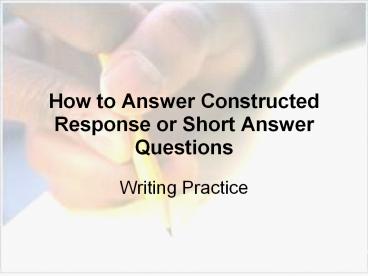How to Answer Constructed Response or Short Answer Questions - PowerPoint PPT Presentation
Title:
How to Answer Constructed Response or Short Answer Questions
Description:
How to Answer Constructed Response or Short Answer Questions Writing Practice Constructed Response or Short Answer Questions: They ask you to apply your knowledge and ... – PowerPoint PPT presentation
Number of Views:1324
Avg rating:3.0/5.0
Title: How to Answer Constructed Response or Short Answer Questions
1
How to Answer Constructed Response or Short
Answer Questions
- Writing Practice
2
Constructed Response or Short Answer Questions
- They ask you to apply your knowledge and
understanding in a short written answer. - Difference between a constructed response and
short answer - A constructed response will always have a
document to analyze with the question. - A short answer may or may not have a document to
analyze with the question so they are very
similar.
3
How To Write A Constructed Response
- PLANNING
- Read the entire question.
- Identify and underline key words in the question,
such as explain, elaborate, illustrate. - Restate the prompt in your own words to be sure
that you understand it. - List items you should identify in your answer
- List facts examples to support your answer
4
R.A.C.E.
- Reword
- Answer
- Cite Evidence
- Explain
5
R.A.C.E
- WRITING
- Reword restate the question and make it into a
statement as a part of the answer you provide. - Example
- Ques - "What color is the sky?"
- Correct written answer - The color of the sky is
usually blue," or words to that effect.
6
R.A.C.E
- ANSWER show how you arrived at your answer with
general reasons. Usually R A in R.A.C.E. are
in the same sentence. - Example
- What color is the sky?
- REWORD The color of the sky is usually blue,
- ANSWER because of how we see light waves and
the weather conditions.
7
R.A.C.E
- Cite Evidence/Examples Use the facts or
examples to support the R A in R.A.C.E - At least 3 Evidence or Examples
- EXAMPLE
- The Sky is usually blue because of how we see
light waves and the weather conditions.
According to scientist, humans see blue sky based
on what kinds of light waves are visualized in
the eye, how sunny the day is and the direction
of the sunlight.
8
R.A.C.E
- EXPLAIN THE ANSWER Elaborate on the evidence
and examples you cited in C. - EXAMPLE
- The Sky is usually blue because of how we see
light waves and the weather conditions.
According to scientist, humans see blue sky based
on what kinds of light waves are visualized in
the eye, how sunny the day is and the direction
of the sunlight. On a clear, sunny day, the sun
is directly shinning on us. Because the
molecules in the air reflect the scattered blue
light waves more than red or orange when it
bounces off the direct sunlight, we see blue. As
the sun sets, the direction of its light goes
away from us so the molecules reflect the red or
orange waves of light that we see at sunsets.
9
YOUR TURN
- Why was the Roaring 20s called Roaring?
- Remember
- Reword
- Answer
- Cite
- Explain
10
Learning Objectives
- Identify and explain the Constructed
Response/Short Answer Rubric Criteria - Practice using the Short Answer Rubric with given
Short Answer. - Assess individual work using Short Answer Rubric.
- Peer Review individual work using the Short
Answer Rubric
11
The Rubric
- 4 Point Constructed Response/Short Answer Rubric
- Understanding (R.)- 1
- demonstrates an understanding of the question
and/or document - Your answer shows that you
understood the question and / or the main idea of
the reading. - Accuracy (A.)- 1
- answers all parts of the question accurately
using correct, factual information (number of
parts will depend on the questions) - Evidence (C.) - 1
- use specific evidence to back up answer
- Explains (E)- 1
- explains the answer thoroughly and logically - In
other words, provides enough information to back
up the answer in a way that makes sense. - Total 4 points (may also be 1/2 points for a
total of 2)
12
Practice Using the Short Answer Rubric
- Read the following Short Answer Response
- Assess the Short Answer using the Rubric Criteria
- Give feedback on how to improve using the words
on the criteria
13
Why was the roaring 20s called roaring?
- The Roaring 20s was probably called roaring
because the events that occurred during the
decade had a loud, deep and lasting impact on
America. The 20s had a loud roar coming from the
a new music revolution called the Jazz Age, from
Americans rebellion against prohibition that led
to the growth of speakeasies and bootleg alcohol,
and from the attitude of many Americans to eat,
drink, and be merry. The 20s roar was deep
because it brought about a lot of cultural
conflicts that questioned American values and
traditions. These cultural conflicts included
issues of evolution v. fundamentalism with the
Scopes Trial the nativists views against
anything not American that led to the growth of
the KKK and violent attacks against immigrants
and Blacks and the issue of traditional
Puritan values v. the new attitudes of
consumerism. Finally, the 20s roar was lasting
because it brought about significant changes in
the everyday lives of Americans including the
mass production of the car, the wide use of the
radio allowing Americans to have similar
experiences, and development of modern
conveniences like the washing machine and vacuum
make more leisure time available for Americans
to do other things. In all the 20s roar left a
lasting impression.































